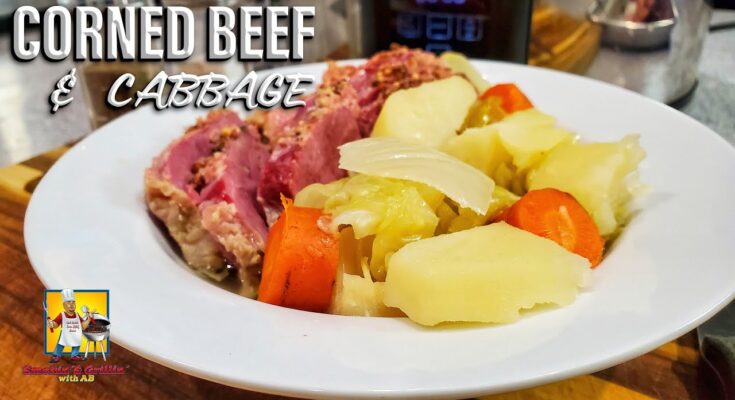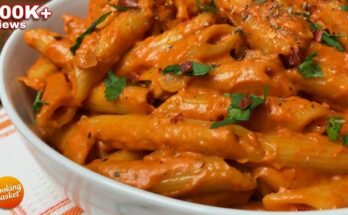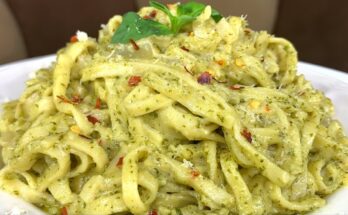Best Corned Beef and Cabbage Recipe: There’s something truly comforting about a big plate of corned beef and cabbage. Whether you’re celebrating St. Patrick’s Day or just craving a warm, hearty meal, this recipe hits all the right notes.
Tender, flavorful beef, perfectly cooked cabbage, and earthy root vegetables come together for a classic dish that never goes out of style.
Let’s dive in and walk you through every step of making the best corned beef and cabbage ever!
Introduction to Corned Beef and Cabbage
Corned beef and cabbage is more than just a meal—it’s a tradition. While it may be closely tied to Irish-American culture, its origins are far more interesting. Originally, Irish immigrants in America adopted corned beef as a cheaper alternative to bacon, and paired it with cabbage because it was affordable and accessible. Today, this dish is synonymous with St. Patrick’s Day, but don’t let the calendar limit you—this is comfort food gold all year round.
The magic of this dish lies in its simplicity. A big chunk of brisket, brined in a salty, spice-laden mixture, is slowly simmered until it’s meltingly tender. Add in some carrots, potatoes, and of course, cabbage, and you’ve got a meal that’s filling, flavorful, and downright nostalgic.
Why This Recipe Stands Out
So, what makes this recipe the best? For starters, it strikes the perfect balance between savory and subtly sweet. The secret? A blend of spices that enhance the meat’s natural flavor without overpowering it. This recipe also walks the fine line between mushy vegetables and undercooked ones—timing and layering are everything.
Plus, we’re giving you multiple cooking methods to suit your lifestyle. Whether you like the old-school boiled method, the set-it-and-forget-it slow cooker, or the speed and ease of an Instant Pot, we’ve got you covered. And because we know a great meal doesn’t stop at the last bite, we’ll even share some genius leftover ideas to stretch your meal further.
Ingredients You’ll Need
Let’s get to the heart of the dish—what you’ll need. Keep it simple or go gourmet—it’s your call. Just make sure to get quality ingredients for the best flavor.
For the Corned Beef:
- 3–4 lbs corned beef brisket (with spice packet)
- 4–6 cups beef broth or water (enough to cover)
- 2–3 cloves garlic, smashed
- 1 bay leaf
- 1 tbsp pickling spice (if not included)
For the Vegetables:
- 1 small head of cabbage, cut into wedges
- 4–6 medium carrots, peeled and cut into chunks
- 6 small red potatoes, halved
- 1 large onion, quartered
- Salt and pepper to taste
Optional Add-ins:
- 1 tbsp apple cider vinegar (for extra tang)
- 1 tbsp brown sugar (for a hint of sweetness)
- Fresh parsley (for garnish)
Feel free to mix and match based on what you have. The beauty of this dish is its flexibility.
Equipment You’ll Need
You don’t need fancy kitchen gear to make this dish. Here’s what you’ll want to have on hand:
- Large pot or Dutch oven (for boiling method)
- Slow cooker or Instant Pot (for alternative methods)
- Cutting board and sharp knife
- Tongs or slotted spoon
- Serving platter
A meat thermometer can be helpful too, especially if you’re new to cooking brisket. You want the internal temperature to hit around 195°F for the meat to be fork-tender.
Preparing Your Corned Beef
Before you toss that beef into the pot, there are a couple of prep steps that make all the difference.
Rinsing and Soaking
Corned beef is cured in a salt-heavy brine. To avoid an overly salty result, give it a quick rinse under cold water. Some folks even like to soak it in water for an hour or two beforehand to draw out extra salt. It’s not mandatory, but it can really help balance the flavor.
Choosing the Right Cut
You’ll typically see two types of brisket cuts: flat cut and point cut. The flat cut is leaner and slices up nicely—it’s what most recipes (including this one) recommend. The point cut is fattier and more flavorful but tends to fall apart more easily. If you love super juicy, pull-apart meat, go for the point.
Cooking Methods Explained
You’ve got options when it comes to cooking your corned beef and cabbage. Whether you’re all about tradition or love a time-saving shortcut, there’s a method here for you.
Traditional Boiling
This is the old-school way—simple, straightforward, and incredibly effective. The meat simmers low and slow for a few hours until it’s tender and juicy. The key here is patience. Don’t rush it; brisket is a tough cut that needs time to break down. Once the meat is nearly done, you add the vegetables so they absorb all that savory goodness.
Pros: Authentic flavor, easy to monitor
Cons: Takes time, ties up your stovetop
Slow Cooker Method
If you’re a fan of the “set it and forget it” approach, this method’s for you. Toss everything in the slow cooker and let it do its magic. It’s perfect for busy days or if you want to prep ahead. Just be sure to add the cabbage later so it doesn’t turn to mush.
Pros: Hands-off, consistent results
Cons: Takes 8+ hours, less control over texture
Instant Pot Version
Short on time? The Instant Pot is your best friend. You can get tender, flavorful corned beef in about 90 minutes. That’s a fraction of the time, with none of the flavor lost. It’s perfect for weeknight dinners or last-minute cravings.
Pros: Fast, tender results
Cons: Less traditional, requires learning pressure cooking basics
Step-by-Step Cooking Instructions
Now, let’s get to the real action. Follow these steps for a foolproof corned beef and cabbage that’s bursting with flavor.
Step 1: Prep the Meat
Start by rinsing your corned beef under cold water to remove excess salt. Pat it dry with paper towels. Place it in your cooking vessel—pot, slow cooker, or Instant Pot—with the fat side up.
Add your beef broth or water until the meat is almost fully submerged. Toss in your garlic cloves, bay leaf, and spice packet (or your own mix of pickling spices). If using apple cider vinegar or brown sugar, now’s the time.
Step 2: Simmer with Spices
Boiling Method: Bring to a gentle boil, then reduce heat and simmer for 2.5–3 hours (or until tender).
Slow Cooker: Cook on low for 8–10 hours or high for 4–5 hours.
Instant Pot: Set to high pressure for 90 minutes, then natural release for 15 minutes.
As it cooks, your kitchen will smell amazing—like savory, spicy comfort food heaven.
Step 3: Add the Veggies
Once the meat is tender, it’s time for the veggies. Add the carrots, potatoes, and onion first—they need the longest to cook. Simmer or cook for about 15–20 minutes, then add the cabbage wedges for the last 10–15 minutes.
You want the vegetables soft but not falling apart. Timing here is key—layer them in, don’t dump everything at once.
Step 4: Let It Rest
When everything’s done, take the corned beef out and let it rest for 10–15 minutes before slicing. This locks in the juices and makes for cleaner cuts. Slice against the grain for maximum tenderness.
Arrange everything on a big platter—meat slices surrounded by colorful, steamy veggies—and prepare for applause.
How to Slice and Serve
Slicing your corned beef properly is just as important as cooking it well. Always cut against the grain—this means slicing perpendicular to the natural lines running through the meat. Cutting this way shortens the muscle fibers and gives you tender, easy-to-chew slices.
Use a sharp carving knife or serrated blade for clean cuts. Don’t rush it—let the beef rest fully to avoid drying out the juices. Serve your slices atop a bed of cabbage and root veggies for a picture-perfect plate.
For added flair, garnish with chopped parsley or a drizzle of grainy mustard. Some people love a little horseradish cream on the side too.
Side Dishes to Pair With
Corned beef and cabbage is already a complete meal, but the right side dish can take it to the next level. Looking to impress your guests or just want to enhance your dining experience? Here are a few tried-and-true favorites:
1. Irish Soda Bread
No corned beef dinner is complete without a warm slice of Irish soda bread. Its slightly sweet, dense texture is perfect for soaking up all those flavorful juices. Slather it with a bit of butter, and you’ve got the ultimate comfort food combo.
2. Mustard or Horseradish Sauce
If you like a kick, whip up a creamy horseradish or tangy mustard sauce to serve on the side. These condiments cut through the richness of the beef and add a sharp, zesty bite.
3. Roasted Root Vegetables
Not a fan of boiled veggies? Roast up some parsnips, sweet potatoes, and carrots with olive oil and herbs for a crispy, caramelized side that complements the softness of the main dish.
4. Mashed Potatoes
For a creamier alternative to boiled spuds, mashed potatoes are always a hit. Rich, buttery, and satisfying—they’re like a warm hug on your plate.
5. Braised Greens or Kale
If you’re looking for a healthier, lighter side, braised kale or collard greens work beautifully. They add color, nutrients, and just a touch of bitterness to balance the meal.
Bonus Tip: Serve everything family-style on a large platter or board. It’s rustic, visually stunning, and invites everyone to dig in.
Leftover Ideas
Corned beef and cabbage leftovers are the gift that keeps on giving. Don’t toss that extra meat or veggies—turn them into creative, mouth-watering dishes!
1. Corned Beef Hash
Dice up leftover beef and potatoes, then fry them in a skillet with onions and bell peppers. Top with a fried egg for a breakfast that’ll knock your socks off.
2. Reuben Sandwiches
Stack slices of corned beef with Swiss cheese, sauerkraut, and Thousand Island dressing between rye bread. Grill it like a panini and enjoy a deli classic at home.
3. Soup or Stew
Toss chopped meat and veggies into a pot with beef broth, some barley or lentils, and let it simmer into a hearty stew.
4. Shepherd’s Pie
Swap out ground beef for chopped corned beef in your favorite shepherd’s pie recipe. Layer with veggies and mashed potatoes, then bake until bubbly.
5. Tacos or Wraps
Why not get a little creative? Shred the beef and stuff it into tortillas with cabbage slaw, pickles, and spicy mayo for a fusion twist.
With a little imagination, you’ll find the possibilities are endless—and delicious.
Tips for the Perfect Dish
Getting corned beef and cabbage just right isn’t rocket science, but these pro tips will take your meal from good to unforgettable:
- Low and Slow Wins: Whether you’re boiling or slow cooking, patience pays off. Rushing brisket will only give you chewy, tough meat.
- Taste As You Go: Adjust your seasonings along the way. You can always add salt, but you can’t take it out.
- Layer the Veggies: Add them in stages to avoid mushy carrots and limp cabbage.
- Let It Rest: Always let the meat rest before slicing. This keeps it juicy and flavorful.
- Use the Right Cut: Flat cut brisket is easier to slice and serves up beautifully.
And most importantly—don’t be afraid to make it your own. Add a splash of beer to the broth for depth, throw in some garlic cloves, or finish with a dash of vinegar for brightness.
Common Mistakes to Avoid
Even seasoned cooks can slip up with this deceptively simple dish. Here are some common pitfalls—and how to dodge them:
1. Not Rinsing the Meat
That brine is salty! Give the beef a good rinse, or you’ll end up with a salt bomb.
2. Overcooking the Veggies
Boiling everything together sounds easy, but vegetables have different cook times. Add them in layers.
3. Cutting with the Grain
Always slice against the grain to keep the meat tender.
4. Skipping the Spice Packet
That little packet adds a big punch of flavor. If it’s missing, make your own with mustard seeds, peppercorns, bay leaves, and coriander.
5. Not Letting the Meat Rest
Cutting too soon lets all the juices run out. Let it sit for 10–15 minutes.
Storing and Reheating
Storing: Store leftovers in an airtight container in the refrigerator for up to 4 days. Keep meat and veggies separate if you plan to reuse them in different dishes.
Freezing: Corned beef freezes well! Wrap tightly in plastic and foil or use a vacuum sealer. Label and date—use within 2–3 months for best taste.
Reheating: For best results, reheat gently on the stovetop with a bit of broth or in the oven covered with foil. Microwave works in a pinch, but it may dry out the meat.
FAQs about Corned Beef and Cabbage Recipe
1. Can I cook corned beef in beer instead of water or broth?
Absolutely! Beer adds depth and a subtle sweetness. Guinness is a popular choice for a truly Irish twist.
2. What’s the best cut for corned beef—flat or point?
Flat cut is leaner and easier to slice. Point cut is fattier and more flavorful but less tidy. Both are delicious—it’s a matter of preference.
3. How do I know when the meat is done?
Corned beef is done when it’s fork-tender and reaches an internal temperature of about 195°F.
4. Can I make this ahead of time?
Yes! In fact, it’s even better the next day. Just store it properly and reheat gently.
5. Is corned beef and cabbage really Irish?
Not traditionally. It became popular among Irish immigrants in the U.S. as a budget-friendly substitute for bacon and cabbage.
Final Thoughts
Corned beef and cabbage isn’t just a dish—it’s a tradition, a celebration, and a comforting meal that brings people together. Whether you’re making it for a holiday feast or a cozy Sunday dinner, this recipe gives you everything you need to get it just right. From choosing the best cut of meat to creative leftovers, it’s a dish that keeps on giving.
So grab your apron, gather your ingredients, and bring this classic to life in your own kitchen. It’s easier than you think—and even more delicious than you remember.



